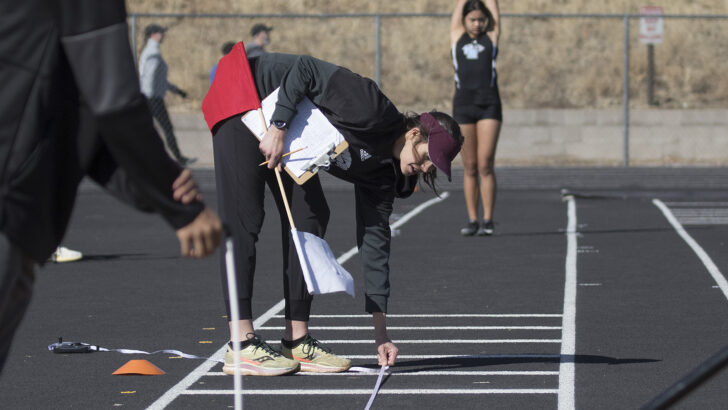The field events in track and field are all about linear measurement. How far did he jump? What height did she clear? How far did he throw?
Several decades ago, and before anyone reading this article was born, the rest of the world decided to go to metric measurements for the field events. Today, about the only place you can find in the world of track and field that still uses English measurements is high schools in the United States.
And that wall is, even as we speak, starting to crumble.
Why? Because metric measurement is a) easier and b) universally recognized. Those two reasons are good enough for me, but let me provide some detail for those who are not necessarily convinced yet.
Let’s talk about easier first. In most states, field event marks are still measured with quarter-inch precision, with one exception The discus is that lone exception, being measured (at least when done correctly) only to the nearest inch.
What most of the fans of high school track and field don’t see is the sausage-making factory that takes field event marks recorded with pencil and paper at the venues and ultimately displays them on web pages and result sheets posted on press box walls. Problems abound. Indecipherable writing, and particularly so where fractions are concerned, from the venue itself is one problem. Tedious transcription of marks from field event sheets into the computer is another problem. Truncated columns in tables of result are occasionally yet another problem.
As if there weren’t enough problems, formatting of results raises its hand and contributes to the aggravation as well. Shall we use dashes or the ‘ and “ characters on our keyboard?
It’s something of a minor miracle that our results come out as accurate as they do. But, it takes way more time than it should take to get there.
By way of contrast, metric field event marks are invariably recorded as a whole number, followed by a decimal point, followed by two decimal places. Ease of recording, both at the venue and in the computer, is enhanced enormously. Every field event except discus is recorded to the nearest centimeter (the second place after the decimal point). Discus marks are recorded to the nearest even centimeter.
It’s no contest whether it’s more efficient to record field event marks in metric or English notation. Metric wins by every conceivable measure.
So, why hasn’t the transition happened already? Like, why not a generation or two ago? In a word, tradition. And tradition can be stubborn.
Part of tradition is that your average American has clear idea of how far a 10.23m throw traveled. It’s nowhere to be found in our shared experiences. We can fix that problem, however, in one season. Or about two weeks for people who don’t make it a point to throw up walls of resistance at every step of the way.
It’s worth noting that USATF is already measuring this way—at every level.
The other parts of tradition can be lumped together into a basket we might label Records and Landmarks.
There’s no need to get exercised about records. Every English record measurement there ever was converts readily to a metric measurement. Properly done, those records need to be rounded off, not rounded up, but you’re losing less than a half an inch in the worst-case scenario. I think the existing records can handle that.
Landmarks? Ah, yes, landmarks. Whatever will we do without some magical numbers like a 50-foot shot put, a 20-foot long jump, a five-foot high jump, or a 100-foot discus throw? To be sure, we will lose all of these landmarks. In their place, however, we’ll welcome several new landmarks. Among those are the 10-meter triple jump and 10-meter shot put. How about the 50-meter discus throw? Every loss is paired with a gain. It’s a wash. Loss of landmarks provides no compelling reason to stay with English marks.
So, is this Alan Versaw just trying to stir up trouble again? No, not really. I’ve spent the last 14 years of my life on the recording end of field event marks. There are few areas in life I can think of where so much unnecessary effort is invested in maintaining an archaic method of doing something. While working at my previous job, I did at least four or five fixes of field event marks for each fix of a track mark. And the sport starts with twice as many track marks as field marks.
There isn’t even an additional cost associated with switching over to metric measurement. The tape measures every team has in their track sheds are already English on one side and metric on the other. Ditto for high jump and pole vault standards.
I have already spoken with Jenn Roberts-Uhlig at the CHSAA offices about switching over to metric field event marks. We wouldn’t be the first state to do it if we did, but we would still be among the leaders. I like the idea of being among the leaders, but that window of opportunity likely lasts only about one more year. I don’t want to be the last person on this earth writing 36’ 4 ¼” for a triple jump mark. Neither do you. 11.08m (and we can dispense with the ‘m’ once everyone is clear that’s the method we’re using) is so much cleaner and easier.
In our conversation, Ms. Roberts-Uhlig was open and receptive to the idea of metric field event marks, but a groundswell of support from track and field coaches prior to next year’s track and field committee meeting would go a long way toward seeing this one through. A united voice of, “Let’s get this done,” would work wonders in seeing this through painlessly. It’s a goal we can all unite around.



